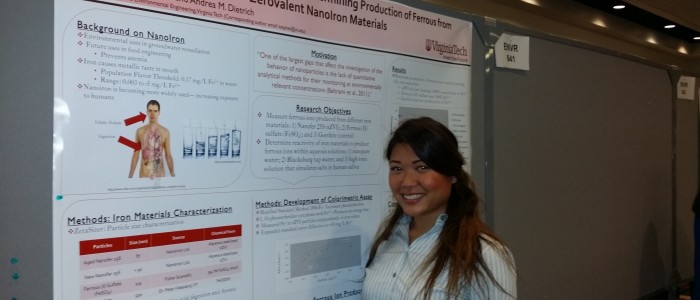Katherine’s research on measuring zerovalent nanoiron materials in water at ACS Conference 2014, San Francisco CA

Katherine Phetxumphou, Water INTERface/CEE PhD student, recently presented her research at the American Chemical Society (ACS) Conference’s ‘Environment’ poster session in San Francisco, CA (Aug 10-14, 2014). A layman’s approach to understanding her work and why it matters:
Through their use in environmental groundwater remediation, humans and aquatic organisms are becoming increasingly exposed to engineered zerovalent nanoiron (nZVI) particles; however, the methods available to measure the reactivity of these nZVI particles are limited. This research aimed to develop a simple colorimetric assay to measure nZVI reactivity at environmentally relevant concentrations.
A detailed description and specifics of her work follow:
Rapid colorimetric method for determining production of ferrous from zerovalent nanoiron materials
Nanoiron materials are being widely used for groundwater remediation, increasing the exposure to humans; thus, methods for measuring reactivity of these materials are needed. Zerovalent iron in nanoiron materials is the active agent, but usually nanoiron particles have an outer coating of iron oxides that are not capable of producing reactive ferrous ion. The total amount of iron in nanomaterials is typically measured through acid digestion and measurement of iron by atomic absorption or inductively coupled plasma-mass spectrometry; this method measures both zero valent iron and iron oxides. A colorimetric method was developed using phenanthroline to react with ferrous as it was produced from dissolution of Nanofer 25S (mean particle size 87 nm). Nanofer 25S is a commercially available nanoiron that is widely applied in environmental research for the oxidation of contaminants and toxicity evaluations. The colorimetric method involves adding Nanofer 25S to a solution of phenanthroline in acetate buffer, incubating for 10 minutes in the dark, and then measuring the color development at 510 nm; quantitative analysis was achieved with comparing to a standard curve generated for varying concentrations of ferrous sulfate. The method is highly reproducible. When applied to Nanofer 25S, approximately 72% of the total iron was measured as ferrous iron. Oxidized iron particles, and also ferric ion, were shown not to react with phenanthroline to produce an absorbance at 510 nm. These findings have future implications for nanoiron reactivity, and its correlation with ferrous iron.


